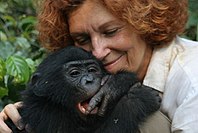Human-animal communication

Human-animal communication means the way people and animals talk to each other. But animals don't use words like people do. They use different ways to communicate, like body language, sounds, smells, and touch.
For example, dogs use wagging their tails to show they're happy, but when they growl, it means they're scared or angry. Cats may purr when they're happy, but also when they're scared or in pain. Horses communicate with each other through body language like their posture, tail, and ear position.
People can also communicate with animals in many ways. We can talk to them, make sounds like whistles, clicks, or snaps to get their attention. We can also use body language and touch to show affection and establish trust.
Human-animal communication is essential for taking care of them properly, especially when they're sick or injured. Vets and animal trainers often rely on communication to understand what the animal needs and how to help them feel better.
It's essential to understand that animals have unique ways of communicating, and we need to be respectful and patient to learn how to communicate in the way they understand. It helps create a strong bond between you and your pet, and animals can enrich our lives by providing love, companionship, and support.
For example, dogs use wagging their tails to show they're happy, but when they growl, it means they're scared or angry. Cats may purr when they're happy, but also when they're scared or in pain. Horses communicate with each other through body language like their posture, tail, and ear position.
People can also communicate with animals in many ways. We can talk to them, make sounds like whistles, clicks, or snaps to get their attention. We can also use body language and touch to show affection and establish trust.
Human-animal communication is essential for taking care of them properly, especially when they're sick or injured. Vets and animal trainers often rely on communication to understand what the animal needs and how to help them feel better.
It's essential to understand that animals have unique ways of communicating, and we need to be respectful and patient to learn how to communicate in the way they understand. It helps create a strong bond between you and your pet, and animals can enrich our lives by providing love, companionship, and support.
Related topics others have asked about:
